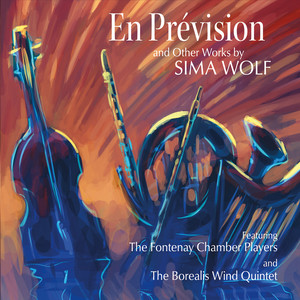
En Prévision and Other Works by Sima Wolf
- 流派:Classical 古典
- 语种:纯音乐
- 发行时间:2016-04-04
- 类型:录音室专辑
- 歌曲
- 时长
-
The Chambers of Hemera
-
Nocturnal Landscapes
-
Brazilian Suite
简介
New chamber works by composer Sima Wolf, featuring The Fontenay Chamber Players and the Borealis Wind Quintet. Colorful, expressive and stylistically varied. "Sima Wolf is a wonderful composer who writes music that is both natural and inspired." - John Corigliano "Sima's music flows through the listener like the river of life itself. With every twist and turn, it carries you with exuberance and intricacy. She composes music that I want to hear time and again." - Barbara Higbie Track 1: En Prévision (for harp, flute, clarinet & string quartet) was written for the Fontenay Chamber Players, inspired by their repertoire and love of French music. The phrase “en prévision” translates as “in anticipation, in readiness” and, in this case, positive anticipation of what’s about to happen. More specifically, I wanted to suggest the feeling of looking forward to what life has to offer. The piece is episodic in structure, moving through various events and environments. It begins with a “calling-together” for all the instruments, followed by an extended solo for harp. After the entrance of the bass clarinet, a melodic theme is stated, followed by an exotic interlude for flute and harp, later joined by clarinet. Ideas from the opening return–even more disparate–with a floating-away cadenza featuring the bass clarinet. Tracks 2, 3, 4: The Chambers Of Hemera (woodwind quintet), a work in three movements, was written for the Borealis Wind Quintet. Hemera, Greek Goddess of the Daytime, honors beauty in the world and inspires us to awaken to the life around us. I: Benevolent Dream was inspired by a particularly vivid dream of flying over a landscape full of rich, gorgeous colors. The dream’s “message” was to enjoy and appreciate the journey ahead. Beginning with an ostinato that suggests motion, a melody floats above. The journey develops into an array of pastel color and modal melody. Phrases of question-and-answer build contrast and intensity. The opening ostinato returns and melodies climb to a joyous peak. II: Unfolding reflects my experience of sitting in stillness in several of my favorite places: listening, watching, feeling the sun and wind. Players enter on a single unison note, fanning out and settling into chords, evoking the image of a serene pond with blossoming water lilies. Dragonflies come zooming by; the wind ripples through the trees–a feeling of profound beauty and peace. III: Ebullient Tricksters is a playful and quirky game of chase. The odd tonalities and off-beat phrases are suggestive of a “Crazy Circus”, implying fun, friendship, laughter, and exuberance. Track 5: Island (string quartet) is an exploration of string sonorities and melodic motifs. I was especially interested in open 5ths and overlapping interrelated phrases. The 5/4 meter suggests the motion of waves–water and wind–asymmetrical with regular repetition. Track 6: Birds Of A Feather (string quartet) is based on abstracted variations on a well-known popular song, the title of which also refers to birds (I’ll let the listener guess this one). Motivic derivations include ascending 5ths, falling chorale-like lines, and fragments of harmonic progressions. Track 7: Awakening (flute solo) was originally conceived as a duet between musician and dancer. It begins with the simplicity of the breath. Melodic phrases develop gradually, evolving through repetition, in a floating perception of time and meter. The energy aspires upward and outward, finding definition and clarity. In the second half, tonality and meter are established, although the 6/8 time is varied by irregular phrases. The piece winds down with a return to long tones reminiscent of the opening. Tracks 8, 9: Nocturnal Landscapes (piano solo) is a pair of piano pieces depicting the night sky. During my visits to Southern Vermont, I loved to watch the mountain range during the change of light from sunset through twilight into darkness, gradually revealing more and more stars. I: Nightwatch begins with a slow ostinato in the low register of the piano. A “G” pedal-tone is prominent throughout the piece, suggesting the “groundedness” of the earth. Gradually events arise, depicting the occasional tree frog, cricket, owl, and the emerging starlight. As night-time activity grows, the piece moves up in register and density, builds to a peak, and returns to the opening ostinato. II: Radiant Sky is an expression of stellar brilliance and scintillation. The piece is structured by three alternating textures. The first is a pattern of overlapping triads in the high register, with the right hand crossed over the left; next is a rhythmic drum-like pattern in the low register; the third a slow, almost romantic melodic interlude. Although more abstract, “G” is also the root tone of this movement. Tracks 10, 11, 12: Brazilian Suite (for harp, flute and percussion) is a set of three movements, each of which reflects a particular musical form indigenous to Brazil. I: Dança Voador is based on the choro (an instrumental etude-like popular Brazilian genre). The word “voador” implies the meaning of both “flying” and “swift”. The piece breaks somewhat from a traditional choro with the improvisational percussion section. II: Reminiscência is essentially a bossa nova. The mood is sad but sweet. Typically, lyrics from this type of song recall a long-lost love affair, a favorite town or place, or remembrance of an idyllic time in one’s life. III: Espìrito Africano is a fiery dance in 12/8 meter. This movement reflects influences from African music and jazz, both of which thrive in the music of Brazil. Thanks to Memo Acevedo for filling out the percussion parts with his heartfelt musicality, imagination and utmost sensitivity to the music.

